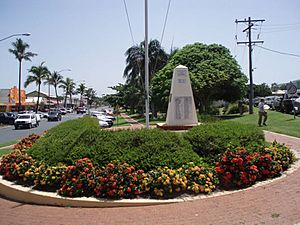Yeppoon War Memorial facts for kids
Quick facts for kids Yeppoon War Memorial |
|
|---|---|

Yeppoon War Memorial, 2009
|
|
| Location | Normanby Street, James Street and Anzac Parade, Yeppoon, Shire of Livingstone, Queensland, Australia |
| Design period | 1919 - 1930s (interwar period) |
| Built | 1921, 1984 |
| Official name: Yeppoon War Memorial | |
| Type | state heritage (landscape, built) |
| Designated | 23 July 1999 |
| Reference no. | 602126 |
| Significant period | 1920s, 1950s, 1980s (fabric) |
| Significant components | memorial - cairn, memorial - obelisk, plaque, memorial - tree/avenue of trees |
| Lua error in Module:Location_map at line 420: attempt to index field 'wikibase' (a nil value). | |
The Yeppoon War Memorial is a special place in Yeppoon, Queensland, Australia. It is made up of rows of trees and a tall stone monument (called an obelisk). This memorial remembers the brave soldiers from the local area who fought and died in different wars.
It was first built in 1921 and later updated in 1984. Because of its importance, it was added to the Queensland Heritage Register on 23 July 1999.
Contents
Why Do We Have War Memorials?
War memorials became very important in Australia after World War I (1914-1918). This war had a huge impact on families and towns. Many soldiers did not return home.
Because bodies could not be brought back from overseas, memorials became a way for communities to grieve and remember. They were seen as sacred places, like empty tombs, where people could honour those who were lost.
How Did the Yeppoon Memorial Start?
The Yeppoon War Memorial began with trees. In 1921, rows of trees were planted along The Esplanade, James Street, and Normanby Street. These trees were a living tribute to the soldiers.
The trees chosen were Hoop Pines. These native Australian trees were perfect because they are strong, can handle the seaside weather, and can live for hundreds of years. This made them a great symbol of lasting remembrance. At this time, The Esplanade was renamed Anzac Parade.
Changes and Additions Over Time
While the trees on Anzac Parade grew well, those on James Street struggled over the years. Many of the small plaques that honoured individual soldiers also disappeared.
In 1984, the Yeppoon Returned Services League (RSL) and the Livingstone Shire Council worked together to fix this. They planted new Palm Trees in James Street. They also added new brass plaques set into small concrete markers. These new plaques remember 29 local people who served. The memorial was also updated to include those who fought in World War II, the Korean War, and the Vietnam War.
The Obelisk in Beaman Park
In 1952, a tall stone monument called an obelisk was placed in Beaman Park. This obelisk became the main part of the Yeppoon War Memorial. It includes an original marble honour board from the Yeppoon railway station. This board lists 68 local men who joined up for World War I.
A marble plaque that says "Lest we forget" was added above the names. More plaques were also added to the obelisk to remember those who served in World War II, Korea, and Vietnam.
What Does the Memorial Look Like?
The Yeppoon War Memorial is spread across three streets and a park in the middle of town.
- Anzac Parade and Normanby Street: Along the beach foreshore (Anzac Parade) and into Normanby Street, you can see rows of tall, mature Hoop Pines. They are spaced out evenly, creating a beautiful green avenue.
- James Street: In James Street, there is a row of Coconut Palm Trees. Underneath these palms, you will find small concrete markers. Each marker has two brass plaques that honour individual servicemen. A couple of the very first plaques are still there on small wooden posts.
- Beaman Park: In Beaman Park, there is a simple white concrete obelisk. It stands on a two-step base. The obelisk has marble tablets on each of its four sides. These tablets list the names of those who served in different wars. The top of the obelisk is shaped like a pyramid.
Why is This Memorial Important?
The Yeppoon War Memorial is important for several reasons:
- Shows History: It helps us understand how Queensland communities remembered and honoured their soldiers after major wars, especially World War I. It shows a time when there was a lot of national pride.
- Unique Design: Avenues of trees as war memorials were not very common in Queensland. This makes the Yeppoon memorial quite special and different from others.
- Community Connection: This memorial shows how much the wars affected the small community of Yeppoon. It highlights the deep importance of remembering those who served.
- Beautiful Landmark: The mature Hoop Pines along Anzac Parade and Normanby Street are a beautiful and well-known feature of Yeppoon. They add to the town's beauty and serve as a constant reminder of the memorial's purpose.

